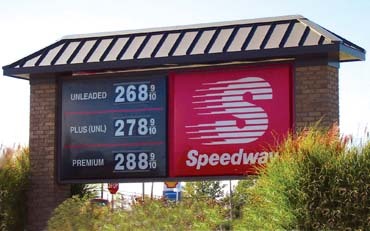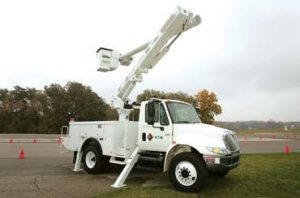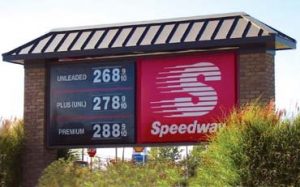Business Management
Reducing Fuel Costs
Tips for economizing your truck fleet
Published
18 years agoon

Throughout the past year, as fuel prices have skyrocketed, many sign professionals have scrambled to prevent higher operating costs from dragging down profits. While many companies are already planning to hike their 2006 rates to reflect these costs, other companies may be locked into longer-term contracts at rates established prior to the recent price surges. Furthermore, sign companies that don’t respond immediately to higher fuel prices can affect competition in local markets.
When fuel prices were relatively low, sign professionals enjoyed wide latitude in choosing company vehicles. But with gasoline prices averaging $3 per gallon nationwide, with rumors of even higher future prices, carefree trucking is probably gone forever.
In April 2000, long before the recent price hikes, the White House launched the 21st Century Truck Initiative, a partnership between truck manufacturers and the Departments of Defense, Energy and Transportation and the Environmental Protection Agency. This initiative’s goal is to develop new technologies for increasing commercial trucks’ fuel economy by decade’s end.
More recently, in cooperation with the U.S. Army’s National Automotive Center, the nonprofit WestStart-CALSTART (Pasadena, CA) has begun working with public and private fleet operators to develop a new breed of fuel-saving, commercial vehicles. This effort is being pursued under the auspices of the Hybrid Truck Users Forum (HTUF), a user-driven, pilot program aimed at speeding development and commercialization of heavy-duty, hybrid trucks.
In May 2005, the Department of Energy held an exhibition of some of the first working prototypes developed under the 21st Century Truck Initiative. One prototype, developed for electric-utility companies, is identical to vehicle types used by many sign companies.
Although fuel-efficient trucks’ benefits are universal, national-security considerations initially boosted this program. With more than 246,000 vehicles, the U.S. Army is aiming to reduce fuel-consumption 75% by 2010. Other government agencies, as well as public-utility firms that operate thousands of vehicles, also have critical fuel-reduction needs.
AdvertisementAlthough your company’s fleet may be tiny by comparison, the savings available through fuel-efficient trucks are no less important. The next generation of hybrid trucks remains largely in development, but sign professionals have some immediate options that can yield significant fuel savings. $image1
Get into diesel
Many sign professionals are already reaping the benefits of diesel power, particularly with regard to heavy-duty trucks that carry cranes or large, aerial lifts. But many companies still use gas-engine trucks, especially pickups, vans and one-ton, flatbed trucks. In the past, many people preferred gas engines’ better acceleration and easier cold-weather starting. But, today’s diesel engines’ performance factors, as well as their fuel economy, have vastly improved.
Diesel engines use approximately 30% less fuel than gas engines. One gallon of diesel fuel contains 147,000 BTUs of energy, while one gallon of gasoline contains only 125,000 BTUs. A diesel engine also has a higher compression ratio than a gas engine. Although diesel fuel is currently more expensive than regular gas, diesel trucks still yield substantial savings.
As for power and durability, diesel engines are vastly superior to gas engines. Because a diesel engine employs a more powerful combustion process, the entire engine is engineered to higher specifications.
While a gas engine may reach old age at approximately 150,000 miles, a diesel engine often runs for 300,000 miles or more. Some people are concerned about diesel engines’ maintenance costs or their reputation for emitting noxious exhaust fumes. Large fleet owners, however, have proven that diesels are substantially less expensive to maintain than gas engines. In addition, improved fuel-injection systems and diesel fuel’s reduced sulfur content make today’s engines cleaner to operate than ever.
AdvertisementBecause a diesel truck’s sticker price, model for model, is higher than that of a comparable, gas-engine truck, some people only focus on front-end costs. But a diesel’s better fuel economy and durability substantially outstrip the initial savings. Furthermore, according to Kelley Blue Book, the resale value of comparably equipped, diesel trucks is significantly higher than gas-engine trucks. $image2
Educate your drivers
In addition to a truck’s inherent features, driving behavior also greatly affects fuel economy. Tests show that efficient drivers average 30% better fuel economy than careless drivers. According to the General Motors Product Service Training Manual for the company’s 6.2L diesel engine, "Speed is more critical on a diesel than a gas engine. On the highway, in the 50 to 75-mph range, its fuel economy will decrease about 3 mpg for each 10-mph increase in speed." By comparison, a gasoline engine loses approximately 1.5 mpg for each 10-mph increase in speed. Thus, a speed of 50 to 55 mph yields the best highway fuel mileage for this GM engine.
Some companies equip their diesel engines with "governors" (throttle controls) that restrict the top speed to 55 mph. This saves money on fuel and enhances safety.
Using a truck’s momentum efficiently is a key factor in proper driving. Drivers who fail to anticipate stoplights or exit ramps waste fuel by hasty and unnecessary braking. This also causes greater wear on brakes. Accelerating as you approach a steep grade provides some additional momentum for a heavy truck, but accelerating at the crest of a hill wastes fuel. The driver should allow gravity to bring the truck back up to speed as it starts downhill.
Diesel engines also run more efficiently than gas engines at lower rpm and during idling. This makes a diesel engine a better option for service trucks that incorporate power-takeoff equipment, or when the engine must idle periodically to recharge equipment batteries. Because diesels are most efficient within a relatively narrow rpm range, "winding out the gears" prior to shifting wastes fuel. The same applies when downshifting.
AdvertisementThe truck’s rear-axle gear ratio greatly affects fuel economy. For example, when paired with a 3.42 gear ratio, the GM 6.5TD engine (available on GM’s 3⁄4-ton and 1-ton models) averages 21 mpg at 65 mph. With a 4.10 gear ratio, fuel economy decreases to 15 mpg at the same speed. Unless the truck regularly tows a trailer weighing more than 4,000 lbs., the 3.42 gear ratio would be a much better choice. When choosing a particular gearing option, therefore, consult the manufacturer’s specifications regarding your intended use.
Increasingly, fleet owners today prefer automatic transmissions, even for large and heavy trucks. Typically, these transmissions are equipped with overdrives for highway cruising. When a truck’s overdrive isn’t working properly, however, fuel economy can be cut by 1 to 5 mpg. The driver usually can hear a transmission shift into overdrive, but, if you have any doubt, have a mechanic check it.
Trucks of the future
For at least one manufacturer, the future of diesel-electric hybrid trucks is now. Hino Motors, the heavy-truck division of Toyota, already offers the Hino 165 Hybrid in Japan. This truck, with a maximum 16,000-lb., gross vehicle weight, is powered by a 4-cylinder, 5-liter diesel engine. In fuel tests conducted by the Society of Automotive Engineers, the truck achieved gains of 14 to 27% in fuel economy compared to a similiar, conventional diesel engine. The hybrid’s greatest fuel-economy gains were recorded in pickup and delivery applications, a use mimicked by many sign companies. Unfortunately, this truck currently sells for more than $100,000.
In a field test sponsored recently by WestStart’s HTUF program, a hybrid utility truck developed by International Truck and Engine Corp. (Warrenville, IL) achieved a 40 to 60% reduction in fuel consumption with substantially lower emissions. At a price of $2.70 per gallon, each of these trucks would save its owner $3,500 to $4,500 per year.
To enable businesses to realize such savings, however, hybrid trucks must be built in sufficient quantities to make them affordable. How soon these vehicles become commercially viable depends primarily on market demands. Tax credits for medium- and heavy-duty, hybrid vehicles, passed by Congress under the Energy Policy Act of 2005, may influence demand.
These benefits range from $1,500 to $12,000, depending on the truck’s weight and the increased fuel economy compared to a non-hybrid truck. Under the current rules, the WestStart-tested truck would qualify for a maximum $12,000 tax credit.
Although much of the recent energy news has been gloomy, sign professionals can economize by upgrading their truck fleets and educating their employees about efficient driving practices. In addition, it’s worthwhile to keep abreast of the latest developments in hybrid trucks.
Note: To learn more about the development of commercial, hybrid trucks, contact George Survant, user lead of the HTUF Working Group at George_Survant@fpl.com

SPONSORED VIDEO
Introducing the Sign Industry Podcast
The Sign Industry Podcast is a platform for every sign person out there — from the old-timers who bent neon and hand-lettered boats to those venturing into new technologies — we want to get their stories out for everyone to hear. Come join us and listen to stories, learn tricks or techniques, and get insights of what’s to come. We are the world’s second oldest profession. The folks who started the world’s oldest profession needed a sign.
You may like

American Sign Museum Names New Executive Director

3 Things Print Pros Must Do to Build Stronger Relationships in the Interiors Market

Graphics Turn an Eyesore Cooler Into a Showpiece Promo in Historic Plaza
Subscribe

Bulletins
Get the most important news and business ideas from Signs of the Times magazine's news bulletin.
Most Popular
-

 Tip Sheet1 week ago
Tip Sheet1 week agoAlways Brand Yourself and Wear Fewer Hats — Two of April’s Sign Tips
-

 Photo Gallery2 days ago
Photo Gallery2 days ago30 Snapshots of the 2024 ISA Sign Expo
-

 Ask Signs of the Times4 days ago
Ask Signs of the Times4 days agoWhy Are Signs from Canva so Overloaded and Similar?
-

 Real Deal1 week ago
Real Deal1 week agoA Woman Sign Company Owner Confronts a Sexist Wholesaler
-

 Benchmarks6 days ago
Benchmarks6 days ago6 Sports Venue Signs Deserving a Standing Ovation
-

 Editor's Note2 weeks ago
Editor's Note2 weeks agoWhy We Still Need the Women in Signs Award
-

 Women in Signs1 week ago
Women in Signs1 week ago2024 Women in Signs: Megan Bradley
-

 Photo Gallery1 week ago
Photo Gallery1 week ago21 Larry Albright Plasma Globes, Crackle Tubes and More













